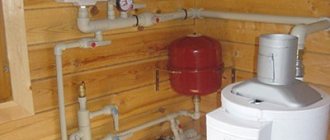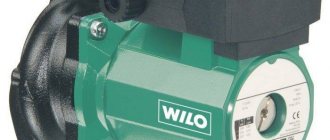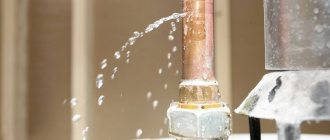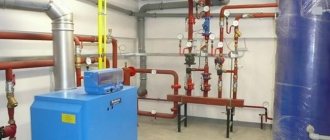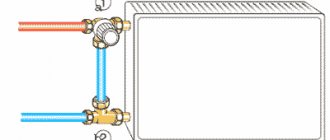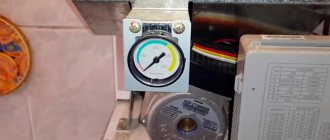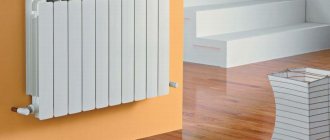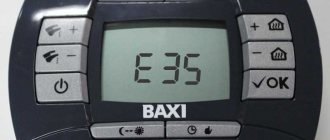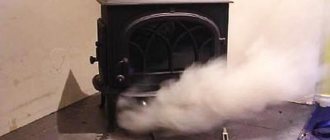Some consumers complain that the last radiator in their home does not heat. This factor causes a lot of inconvenience, because one of the rooms does not warm up and the apartment owner is forced to use additional heating equipment.
Most often, the reasons why a heating radiator does not perform its assigned functions are global and include:
- Incorrect installation or connection;
- Insufficient pressure under which coolant is supplied to the system;
- Lack of balancing.
To find out the reason, it is recommended to contact professionals, but if this is not possible, you can try to solve the problem yourself.
Basic information about the design of the heating system
The heating system comes in two types: one-pipe, the so-called Leningradka, and two-pipe. In apartment buildings, single-pipe is predominantly used. The vast majority of individual properties and recent new buildings use a two-pipe system.
In a single-pipe system, the coolant enters a single riser, from where it is distributed to the radiators. Supply is carried out from the first or last floor, which is not of fundamental importance. Bypasses are used to ensure uniform water supply to all batteries. Thanks to them, the required amount of water enters the radiator, the rest moves to the next sections. The disadvantage of a one-pipe system is that batteries that are located closer to the inlet or boiler warm up better. The furthest ones in the system may not warm up enough.
Two-pipe heating system
In a two-pipe system, each radiator is independently connected to two risers. Hot water is supplied from one, cooled water goes to the other. Ignorance of the features of heating systems of various types sometimes leads to dire consequences, especially when unskilled workers are involved in repairs.
Infrequently, but there are cases when old batteries in a single-pipe system are replaced with modern aluminum ones. The expected effect does not occur, because aluminum appliances are designed for a two-pipe system, the coolant current weakens. Moreover, due to poor water circulation, they become clogged. There is only one way out - to repair old batteries or install new ones suitable for a single-pipe system.
Low pressure
The bottom of the battery may be colder than the top due to insufficient pressure in the system. If the main system is designed for cast iron pipes, then the water supply force in it is quite low. Installing bimetallic batteries means that the coolant is simply not forced through the narrowed passages inside the radiator.
In a private house with a membrane expansion tank, the pressure in the system can be raised manually. Residents of apartment buildings will have to contact their service provider to resolve the issue. Also, repair work may be carried out on the central highway, after which everything will return to normal.
Pressure gauge showing system pressure
Often the bottom of the battery is cold, and the top is hot, which can occur due to unlawful actions of neighbors of an apartment building :
- Installation of water-type heated floors.
- The bypass was mounted on a common heating supply pipe.
- The volume of radiators was increased without the approval of the technicians.
The main reasons for poor battery warm-up and how to eliminate them
There are two main reasons why batteries do not heat up - air lock and clogged radiators. The air lock interferes with the circulation of the coolant, the radiator does not warm up well or remains cold. The way out of the situation is simple - remove the air.
Modern systems have a special tap at the top of each battery for bleeding air. It is turned with a screwdriver or adapter. If there is air in the system, you will hear a hissing sound. The tap is kept open for some time until coolant flows out of it. If the air lock is very large, it may not be possible to completely bleed the air at one time. Wait ten minutes and try again until you feel the battery warming up completely.
Air bleed valve
Do not release a lot of coolant, hoping to remove air along with it. This threatens a loss of pressure and possible shutdown of the boiler in a private home.
On cast iron radiators that have been installed for a long time, there is most likely no air bleed valve. The simple job of bleeding the air turns into a complex and dirty one. There are two approaches to removing air from a cast iron battery. The first is through the coupling on the coolant supply to the radiator, the second is by loosening the plug in the battery. In each case, it is not necessary to completely unscrew the coupling or plug; they are turned a little until a hiss appears.
It is important to determine in which direction the coupling or plug should be unscrewed, because radiators use both right-hand and left-hand threads. Where the coupling turns is determined by the protruding part of the thread. The letter “L” is stamped on the plug with a left-hand thread; turn it to the right. It is important not to overdo it, especially when unscrewing the coupling, because the pipes can be rusty and can collapse from excessive force. Just in case, before screwing, wrap a little tow with paint or fumlenta onto the threads so that water does not seep through the broken connection.
Clogged radiators are the main cause of poor heat supply
Clogged radiators are the second common cause of poor heat supply. The system becomes clogged for two reasons: physical wear due to long-term use or the supply of dirty water to the system without filtration. More often than not, salts have been deposited on the inner walls for many years and the system becomes clogged. Sometimes the deposits are so thick that the coolant is completely unable to get through the narrow cracks. There is only one way out - replacing the radiators, and sometimes also the pipes.
Do not drain water unless absolutely necessary. Each dose of fresh water adds sediment and clogs the system.
If the clogging is minor, the batteries are washed. It is better to carry out work when the heating is not working. If you have to resort to such an operation during the heating season. Then disconnect the batteries by turning the taps and remove. Not all systems have valves to turn off radiators. Before cleaning the system, water is drained in individual properties; in a multi-story building, the supply is shut off. During the heating season, be careful - the water is very hot.
Clean the battery under high pressure. To do this, take the batteries outside, tightly connect the battery with a water source with a hose and blow it out. Rinsing with water from the tap will not work; some of the debris will still remain in the radiator. If a blockage is found in one battery, flush the others as well; they are almost certainly clogged too.
How to eliminate air locks in radiators
Air lock is the most common cause of cold radiators. The appearance of air is a natural process caused by heating the water, sudden filling of the system, and a violation of the tightness. Fixing this problem is not difficult if the system is equipped with bleed valves. On modern radiators they are located at the top of the product and operate without intervention, periodically bleeding air from the batteries. If automation is not provided, then the valve is opened manually and air is released until water appears.
Modern heating devices are equipped with special valves
Older type heating appliances do not have such taps. In this case, you will have to work a little and remove the plug. Before you start unscrewing, be sure to place the basin on the floor. Under no circumstances should the lid be completely unscrewed; it should only be unscrewed slightly until a barely audible hiss appears. At this point, you need to put the key aside and wait until all the excess air comes out of the system and water begins to ooze out. After this, the plug must be carefully tightened. Just in case, you can leave the basin for a while to make sure that water does not drip.
Why doesn't the battery warm up in a private house?
In the private sector, in addition to the above reasons for unsatisfactory heating performance, there are others. Private houses have almost 100 percent autonomous heating. The cause of poor heating may be the heating boiler. Most likely, the boiler power is calculated incorrectly; it is not enough to heat the coolant to an acceptable temperature. If the automatic boiler does not turn off, this is a sure sign of insufficient power.
Properly equipped boiler room
If the boiler is running, the liquid will still warm up. When the radiators are completely cold, the heating unit is broken or does not turn on. Modern boilers turn on when the minimum pressure level in the system is observed. The boiler will not turn on if it is less. Also, modern boilers are equipped with a security system. For example, in a gas boiler there is a sensor that is responsible for ensuring that exhaust gases go into the chimney. If for some reason the smoke does not go away completely, the automation will work, the boiler will turn off and will not turn on until the problems are corrected.
What other reasons are there why the battery in the house does not heat? The pressure in the system may be too low and, as a result, circulation is disrupted. If the batteries are old, this reason is unlikely, because two atmospheres (the usual pressure of a home system) is enough for them. But some modern batteries require higher pressure. Before installing them, it is worth looking at the passport to see if the system can create the required pressure.
You can slightly increase the pressure in the system by installing a circulation pump with an appropriate system capacity.
Since heating in private homes is often done by people who are illiterate in this regard, installation errors are possible, causing the heating to be weak. It is believed that the use of a single-pipe system saves pipes, but due to the peculiarities of the system, the heating of the batteries weakens as they move away from the boiler or they remain completely cold. In addition, batteries remote from the boiler should have more sections. It's impossible to save money.
Two-pipe system
In a private house, a two-pipe system is much more efficient, but errors are possible during its installation, which will affect the heating efficiency. Such errors include:
- incorrect installation of shut-off valves;
- incorrectly connected batteries;
- The pipe diameters were selected randomly.
With such errors, effective circulation is not ensured and the heating battery does not warm up. There is only one way out - to invite a specialist and eliminate the errors. And in order not to pay twice, initially entrust such responsible work to a proven, qualified specialist.
Need to fix the problem
If the heating season has already begun, and utility services do not want to provide heat to apartments, then you need to try to solve this problem. It also happens that at the height of the heating season the batteries remain barely warm, then consumers of central heating services begin to decide where to turn.
Experienced lawyers recommend starting to call the appropriate authorities. Utility workers must respond to problems that are expressed in completely cold radiators. In this case, the pipes may be hot. Consumer requests must also be responded to in cases where the radiator is only partially warmed up. One heating element may remain cold while all the others may be hot.
Before contacting the appropriate services, you should familiarize yourself with the temperature conditions in heated rooms prescribed in the regulatory documentation.
Some tips for craftsmen
Many problems can be avoided if you do a few things first. Autonomous heating of a private house has an expansion tank for the system. If you weld a faucet to the lower pipe and gradually feed water into it, the air lock will escape through the tank. The system is filled with water through the same tap, then plugs will not appear. The only thing required is an assistant to monitor the water level in the tank.
To remove air from cast iron batteries, install a Mayevsky tap on the top plug. This is not at all difficult, you just need to unscrew the plug in the summer, drill a hole of the required diameter in the center and cut the thread with the required pitch. The plugs are made of cast iron, the material is easy to process.
If the battery does not give off heat well for no apparent reason, it may be touching the wall. The larger the contact area, the more heat is wasted. Eliminate contact by moving the radiator slightly away. Do not cover the batteries with decorative grilles, which reduce heat transfer. It is better to attach a reflective screen made of foil material behind the radiator - heat transfer will increase.
The heating system seems simple only at first glance, but in fact it has its own secrets and tricks. Everything seems complicated and confusing for a beginner. But once you understand the issue, the main points become clearer.
The master's work is afraid!
So, as you can see, the heating system can be fraught with a large number of tricks and tricks. It’s not always possible to immediately figure out what to do. If you have never had to figure out the problem of why the radiator does not heat, then, most likely, it will be useful to watch a useful video that will tell you about one method for troubleshooting the problem. In this case, you will be able to solve the problem yourself and without the involvement of specialists.
Every year, many consumers unsuccessfully try to resolve the issue of what to do if the radiators in the apartment do not heat well.
Flow extender
A typical problem for a two-pipe system. Is it possible to make any number of sections? It is possible, but the very last sections of the battery will not warm up. Cause? Water, like a person, looks for “where it’s easier” and follows the shortest path. In order to “teach order” to the lazy one - water, a flow extender is required. Factory-made, or made independently from a piece of pipe. By directing the fluid to the middle of the structure, it will force the flow to circulate correctly, reaching the farthest ends of the heat exchanger.
Interesting fact: the same problem can be solved by connecting the heating device “diagonally”. But this is rarely used, due to the lack of aesthetics of this solution on ready-made systems.
Causes of heating interruptions
The first thing to do is to determine the exact reason for the heating shutdown. Housing office employees or heat suppliers are required to do this. What could be the factors:
- Airiness . Occurs when air was not released from the pipes and radiators when heating was started.
- Impurities in water. This could be rust, plaque, sludge, etc. Most often found in houses with an old communication system, when water pipes have not been changed for more than 10 years.
- Heat supply failure. Occurs when boiler houses do not control pressure. It becomes too low for the coolant to circulate quickly through the system.
- Accident or water leak. A breakthrough can occur both in the pipeline and directly in the apartment.
You can try to independently determine whether the problem is local or house-wide:
- In the apartment. The common riser will be warm, and the heating radiators in the rooms will be cold.
- Throughout the house. There will be no heating in all pipes and in all neighbors.
What should I do if the top of the battery is hot and the bottom is cold? We determine the cause and eliminate it.
Three way valve
Such a tap is required to switch the bypass-battery direction. If this is the reason that the radiator does not heat, then the problem can be eliminated in 3 ways:
- No disassembly. In cases where the tap turns easily, but switching does not occur at all (neither one nor the other works), you can try to develop the device using multiple turning movements. In this case, blockages, as a rule, are washed away by the flow, going into the riser. The operation of shut-off valves is restored in full.
- With partial disassembly. There's no way to turn the tap? We're not trying to break it. Carefully unscrew the locking screw of the handle, remove it, place the screw back in order to prevent deformation of the part during further work. Further actions are carried out with a wrench. It is not recommended to use round nose pliers, pliers, etc. The reason is the same as with the screw - not to damage the rod. Holding the rod with a wrench, we smoothly rock it back and forth, starting with minimal vibrations. If you cannot make minimal movements, slightly loosen the large hex nut that presses the stuffing box seal. If it starts to dig in, place a small container. Continuing the work, moving the rod, press the seal into place, turning the large nut back accordingly. We unscrew the screw, install the handle, screw in the screw, and rejoice.
- In rare cases, when the internal stop is simply torn off, the crane has the ability to “spun in a circle” endlessly - we simply select the position of the handle in which normal operation is ensured.
Doesn't heat up after repair
The battery may not heat up immediately after repair. How to determine what the problem is? Here, what exactly has changed in the apartment will play a big role. For example, pipes can be covered with plasterboard. When installing the profile, the pipe may touch it. As a result, this item will absorb heat that should be directed to the radiator. That is, heat will spread in the space between the rough wall and the drywall. What to do in this situation? To do this, you should check at what level the battery was heated before repair. If after repair it heats less well, then the cause should be quickly eliminated.
